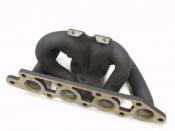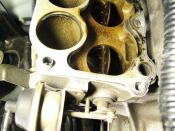Final curve from the dyno session. No ign, fuel or cam timing tuning was done.
98 B20B stock head and block, 94 P75/LS ecu Intake: GSR stock cone filter and tube (no airbox), LS intake manifold, 64mm TB Ex: GSR exhaust manifold, test pipe, Greddy BL exhaust Comments: 128hp to the wheels is rougly 150hp to the flywheel. Interesting since the engine is rated only 126 hp flywheel. The increase in power can probably be accounted to the GSR exhaust manifold, free flow exhaust and the LS intake manifold. The stock cast GSR exhaust manifold that was used looks like a better piece than the stock stamped and welded CRV part. We did not have a matching down pipe for the CRV ex manifold, so we could not try it to be sure. The intermittent glitch at ~6200 was later discovered to be a loose crimp connector on the ignitor.
Since it was occuring after power peak, it really doesn't hurt the results. The 64mm TB probably is not needed at this power level. Not yet ;)The -5 hp stock cat mod. Remember kids, the stock Civic cat is not a high flow design after many years of use and abuse. Brand new Honda cats work good. But over time they start to hurt the flow. Dyno proof right here. We did a couple runs to make sure the car was back up at operating temp to improve the accuracy of the comparison. A new cat is on order.
Look at the torque. Torque you can feel. The lag in the power band from 3.5k- 4.5k will be the target of a future dyno session. You can feel the engine labor through it a bit. But when it reaches 4.2K, hold on, because it ramps up in a...


